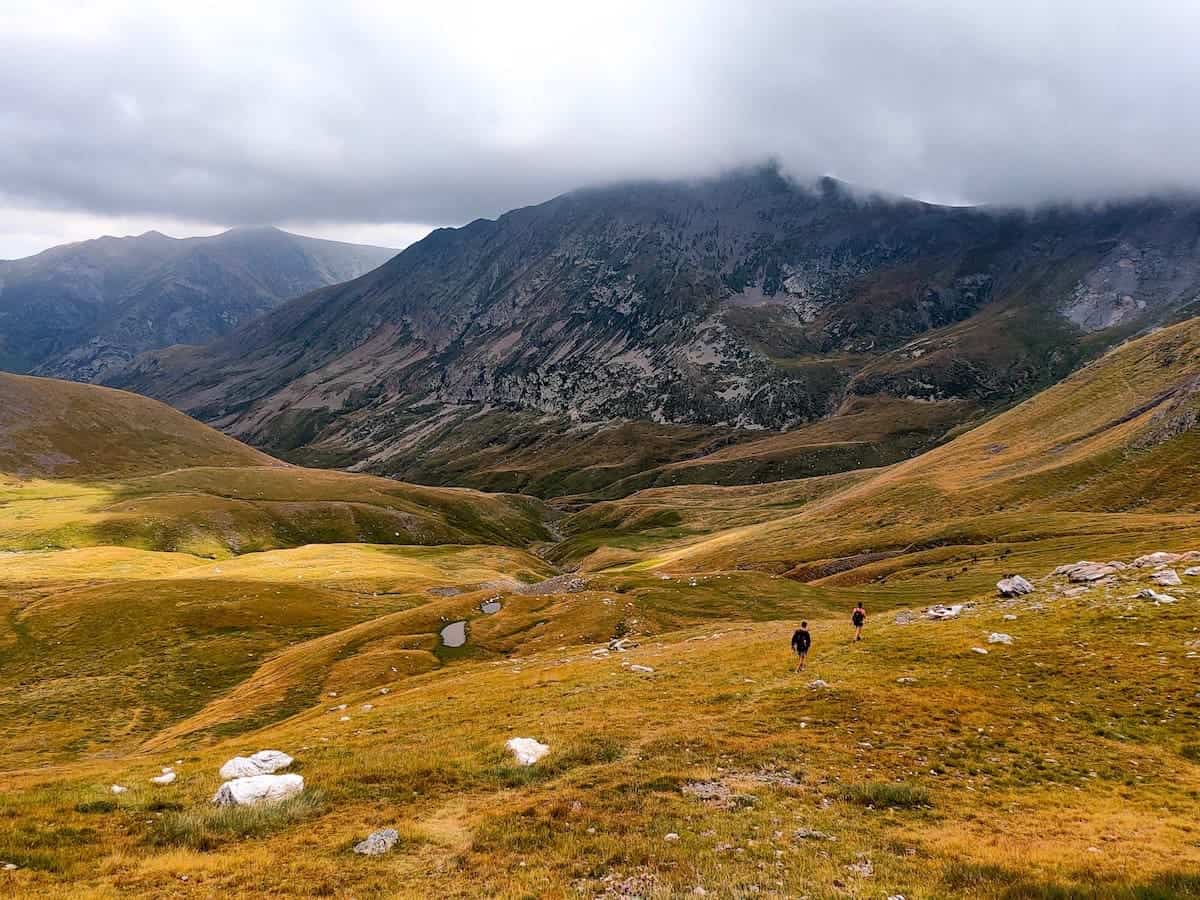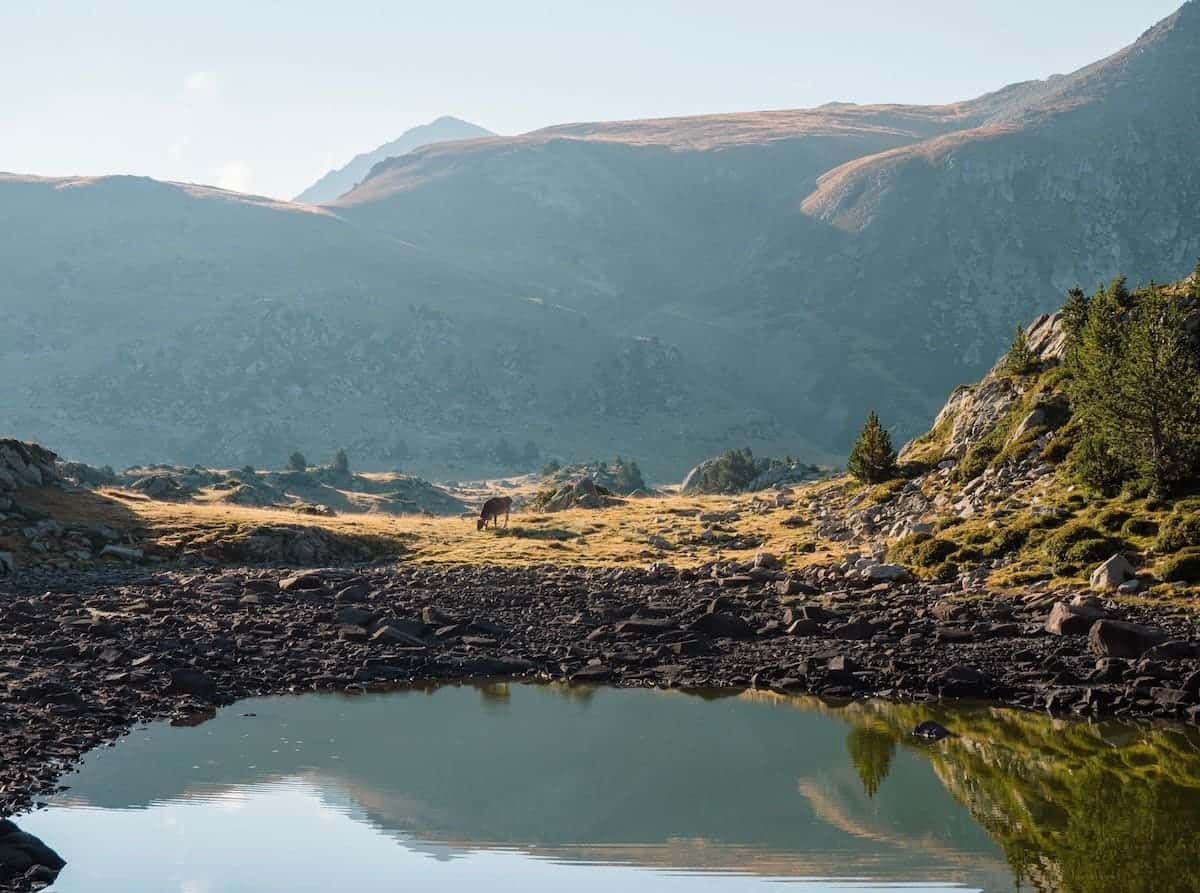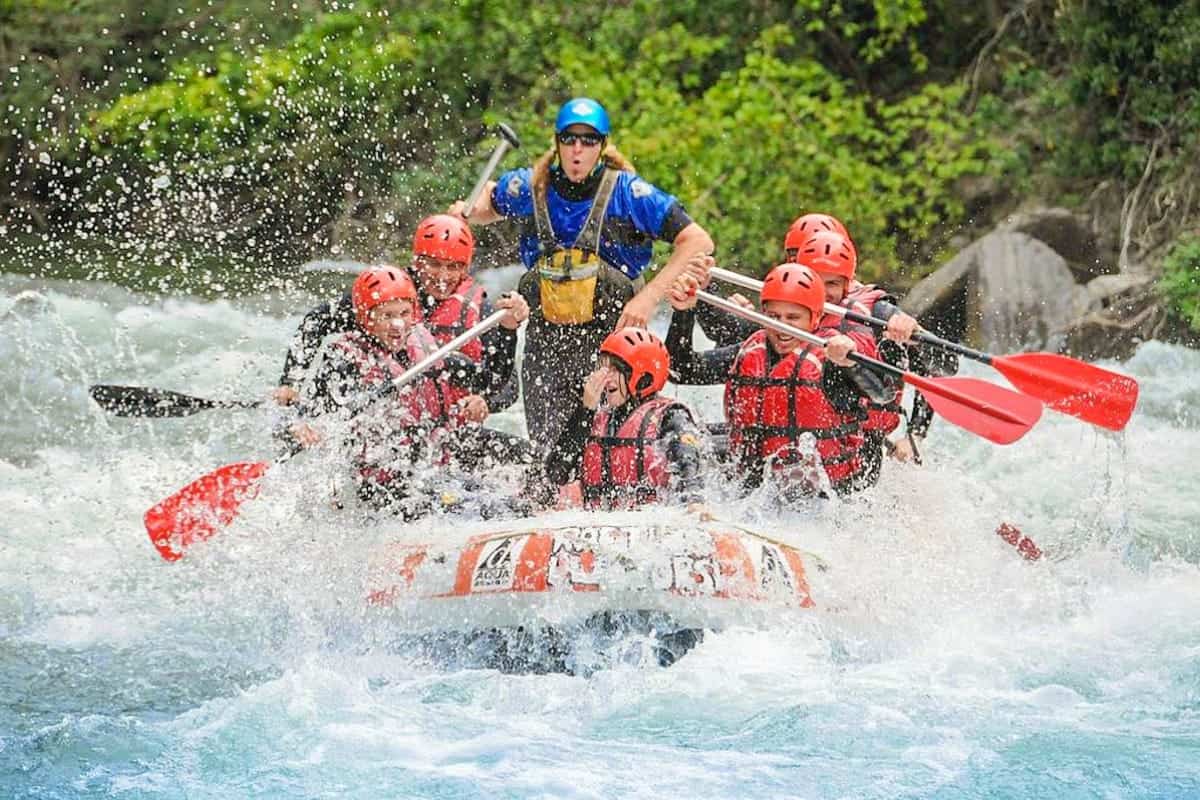Imagine waking up in the middle of the mountains, hiking through lakes, meadows, and forests, ending the day with a hearty meal in a hut, and going to sleep to repeat it all over again the next day. That’s what hut-to-hut hiking adventures feel like, and the Pyrenees are full of them.
Some are circular routes, ideal for a holiday, while others expand through vast distances and are excellent for those of you looking for a greater challenge.
Hut-to-hut hikes are perfect for anyone who wants to experience a multi-day walk while enjoying the pleasure of ultra-light packing, staying in a hut, and going slow.
Over the years, we’ve embarked on several hut-to-hut hiking adventures in the Pyrenees. Here, we’ll help you find which one is ideal for you.
Ready to discover what awaits you in the Pyrenees?
* Post written for the first time in February 2023 and updated in February 2025.
Great hut-to-hut hikes in the Pyrenees

Carros de Foc
🥾 Total distance: 55 km
🟠 Level: Moderate
⬆️ Cumulative elevation gain: 9.200 m
⏱ Duration: Between 4 and 9 days
📍 Location: Catalonia (Spain)
🔄 Circular
👍🏼 Great for: Variety of landscapes
What started as a joke by local hut wardens to visit each other is now one of the most renowned and beautiful hut-to-hut hiking routes in Europe. It’s a circular hike that connects nine mountain huts, or refugis as we say it in Catalan. It takes place in the Aigüestortes i Estany de Sant Maurici National Park, about four hours northwest of Barcelona.
Our highlight of the route was the stunning variety of landscapes, from snowed rocky peaks to lush green valleys that seemed to stretch on forever. We also loved the huts. They were located in spectacular settings and served delicious food we quickly devoured after the long hiking days!
For an in-depth guide on this hike, read our Hiking Carros de Foc post. It includes information on how to get there, what to expect from each section, and which direction is best to follow, among other things.

La Porta del Cel
🥾 Total distance: 63.6 km
🟠 Difficulty: Moderate-Difficult
⬆️ Cumulative elevation gain: 5.500 m
⏱ Duration: 4 days and a half
📍 Location: Catalonia (Spain) and France
🔄 Circular
👍🏼 Great for: Stunning views and climbing peaks (including the highest one in Catalonia)
Translated as the Heaven’s Door, this circular hut-to-hut hiking route is one of our favourites in the Pyrenees. Not only because it climbs the highest peak in Catalonia, La Pica d’Estats (3143 m), but also because the landscapes are mind-blowing.
We found ourselves saying “Wow!” more than once when we stumbled across a crystal-clear alpine lake or admired the views from the several peaks in the route.
The hike links four mountain huts in the Alt Pirineu Natural Park, about three and a half hours from Barcelona. Because of the long stages and the terrain, we recommend it to seasoned hikers with experience in high altitudes.
Think this hike is for you? Then check our La Porta del Cel guide for an in-depth read about this hut-to-hut adventure. You’ll find info on transportation, the huts, and the sections, among other things.

Estanys Amagats
🥾 Total distance: 73 km
🟠 Difficulty: Easy-Moderate
⬆️ Cumulative elevation gain: 3.599 m
⏱ Duration: Between 4 and 5 days
📍 Location: Catalonia (Spain) and Andorra
🔄 Circular
👍🏼 Great for: Number of lakes and the mix of mountain landscape and charming villages
Estanys Amagats is also a circular hiking route that links four mountain huts. It’s just two hours from Barcelona, and you’ll be hiking in both the northeastern part of Spain (in the region of Catalonia) and the tiny country of Andorra.
If you’re a fan of mountain lakes, you’ll love this one! The route’s name actually translates as “Hidden Lakes.” And believe us when we say they gave it this name for a reason… 40 lakes await you along the 73 km journey!
Besides the breathtaking lakes surrounded by mountains, we loved that the route doesn’t take place only at high altitudes. It also passes through some charming little mountain villages. So it’s an interesting combination for discovering both the architecture and the magnificent landscapes of the region.
Curious about this hike? Read our Hiking Estanys Amagats guide to learn more about the route’s sections, the huts, and other essential info.

Travessa dels 3 Refugis
🥾 Total distance: 52.5 km
🟠 Difficulty: Easy-Moderate
⬆️ Cumulative elevation gain: 3.054 m
⏱ Duration: Between 3 and 6 days
📍 Location: Catalonia (Spain) and France
🔄 Circular
👍🏼 Great for: Variety of landscapes and many options to hike nearby peaks along the route
Travessa del 3 Refugis is a circular hike that links three mountain huts in the Capçaleres del Ter i del Freser National Park, about 2 hours north of Barcelona. Part of the route passes through France, and the other through Catalan territory. So, you’ll be hiking in two countries!
This hut-to-hut hiking route in the Pyrenees positively surprised us because of its beauty and variety of landscapes. Think waterfalls, glacier-emerald lakes, and lush forests. There is even a section that seems to transport you to the scenic mountains of Iceland!
To learn more about this hike, read our Hiking The Travessa dels Tres Refugis guide. It includes where to start, what to expect from each section, and which direction to follow, among other essential things to know.

Cavalls del Vent
🥾 Total distance: 84.2 km
🟠 Difficulty: Moderate
⬆️ Cumulative elevation gain: 5.600 m
⏱ Duration: Between 4 and 8 days
📍 Location: Catalonia (Spain)
🔄 Circular
👍🏼 Great for: Amazing food and spectacular sunrises and sunsets
If you’re looking for endless green meadows and Mediterranean forests, Cavalls del Vent has you covered! With over 80 km of track, the circular route connects eight mountain huts in the Cadí-Moixeró Natural Park, about 2 hours north of Barcelona.
The route’s name, which translates as “Horses of the Wind”, comes from the Himalayan prayer flag named Lung-Ta (Wind Horse).
Highlights of this hut-to-hut hiking route in the Pyrenees include watching the sunset and sunrise at 2.510 m of altitude, eating mountain rice and local products after an exhausting day of hiking, and admiring the emblematic Pedraforca mountain.
Curious about this hike? Read our Hiking Cavalls del Vent guide. It provides detailed information about the various sections of the route, the huts, and other essential info for hiking Cavalls del Vent.

Coronallacs
🥾 Total distance: 92 km
🔴 Difficulty: Hard
⬆️ Cumulative elevation gain: 6.449 m
⏱ Duration: 5 days
📍 Location: Andorra
➡️ Circular
👍🏼 Great for: Breathtaking landscapes
Coronallacs is a 92 km circular route that links Andorra’s four guarded mountain huts. It’s an excellent way to discover Andorra’s most remote and scenic spots.
It’s one of the most beautiful routes we’ve hiked, but also a tough one, so we only recommend it to those up for a challenge. With a total elevation gain of 6.868 m, expect long days on the trail, with steep climbs and high mountain passes. That said, if the full route sounds a bit too intense, you can shorten some stages by bus, making it more flexible.
What also makes this route a great choice is that it starts and ends in Andorra’s capital, making it one of the most accessible multi-day hikes in the Pyrenees. Unlike other routes in the Pyrenees, the trailhead can easily be reached by public transport from Barcelona (3h by bus).
Think this hike is for you? Then check our Coronallacs guide for an in-depth read about this hut-to-hut adventure. You’ll find info on transportation, the huts, and the sections, among other things.

Senda Pirenaica (GR-11)
🥾 Total distance: 786 km
🔴 Difficulty: Hard
⬆️ Cumulative elevation gain: 47.500 m
⏱ Duration: At least 35 days
📍 Location: Spain and Andorra
➡️ One way (not circular)
👍🏼 Great for: Challenging yourself and variety of landscapes
Only recommended to experienced hikers, Senda Pirenaica crosses the whole Pyrenees mountain range from the Atlantic to the Mediterranean. Unlike the hut-to-hut hiking routes mentioned before, Senda Pirenaica is not circular. It starts in the Cabo Higuer (Basque Country) and finishes in Cap de Creus (Catalonia), crossing the tiny mountain country of Andorra. This route takes place on the southern side of the Pyrenees, and it never crosses the border to France.
Expect various landscapes, from dramatic canyons in Monte Perdido National Park to fig trees and cacti as you approach the Mediterranean Sea.
The hike is not technically difficult as long as the snow has melted in the high-altitude mountain passes. Nonetheless, the fatigue keeps accumulating day after day, and this is what makes the hike challenging.
You can find more info here on the Senda Pirenaica sections and the hike’s logistics. We also recommend looking at this map, which pinpoints all the huts.
📒 Planning tip
Thinking about hiking the GR-11? We highly recommend using Cicerone’s “Trekking the GR-11 Trail” guide to plan it. We haven’t hiked the GR-11 but have used the guide to plan some stages as a day hike, and we loved the amount of info we found there. Also, because of its small size, we carried it with us during the hikes, and it was super helpful.
Essentials to know before hut-to-hut hiking in the Pyrenees
When is the best season to hike
All of the routes mentioned above are high-mountain routes. Therefore, they are best enjoyed from June to September. Snow can be a problem in mountain passes right into the first week of July. So it’s better to check with the local hut wardens and check the huts’ webcams.
In many parts of the Pyrenees, the weather in summer tends to follow a pattern. It’s usually humid in the morning, but as the sun rises, the humidity disappears, and the skies clear. However, by 3 pm, the clouds gather again, and the chances of thunderstorms and hail increase, especially in August.
Our advice? Start your hike early in the morning. The difference of just two hours can mean the contrast between a clear sky and a storm, and we can assure you, it’s much more pleasant to be caught in a storm while enjoying a coffee in a hut than in the middle of the mountains!
⚠️ Important!
For reliable mountain forecasts, see the local Meteo website. The website is in Spanish, but you can use a translator to browse around. Always check the weather forecast for your hiking area before your departure. You might need to add a last-minute rain jacket or crampons to your backpack!
If you plan on hiking in Andorra, use meteo.ad to check the weather.
What to do in case of an emergency
If you find yourself in trouble, lost, or involved in an accident, stay calm and call for assistance. When calling for help, provide your location (that’s why it’s always crucial to have a map in hand) and explain the situation. If there is a victim, protect them from the cold with an emergency blanket (always pack one!) and administer first aid whenever possible.
Remember that it’s always better to be safe than sorry, so if you face a technical climbing challenge that exceeds your capabilities, get some help.
Although there is no reception in most parts of the Pyrenees, you can dial and reach the Emergency number anyway.
🆘 Useful emergency phone numbers
The emergency service number in Spain, France, and Andorra is 112. Don’t worry if you can’t speak Spanish or French; the operators can take your call in English.
What to expect from a staffed mountain hut in the Pyrenees
Food
🍽 Dinners are early: Spanish people are known for their crazy schedules when it comes to eating. Lunch is usually at 2 pm, while dinner can be as late as 10 pm. Surprisingly, this rule doesn’t apply to mountain huts, where dinners are typically served at 7:30 pm.
🥐 Dietary requirements can be accommodated, but you should ask about them when booking. Hut wardens understand dietary restrictions and can adjust their meals accordingly. However, the meals you can get might be less elaborate than the ones without restrictions. For example, one person in our group was intolerant to gluten, so instead of getting soup with pasta, he got only broth.
☕️ Breakfast times are set. Like dinners, breakfast is served at a specific time, usually from 7 to 9 am. If you wish to leave before breakfast is served the next day, tell the warden as soon as you get to the hut.
Schedules
🕓 Being able to use the dormitory before 4 pm is rare. If you get to the hut before 4 pm, chances are that you won’t be able to access the bedrooms. You can chill on the terrace or stay in the dining room. If it’s sunny, lay on the grass and enjoy an outdoor siesta!
🤫 Silence time starts at 10 pm. Hut wardens usually close the lights at 10 pm, and everybody goes to the bedrooms. You can still read or listen to music with earplugs, but keep things quiet. The bedrooms are mixed. In some, you can find more than twenty mattresses side-by-side, and there is no space between them.
💡 A brilliant idea!
Pack earplugs! In a room with 10 people, chances are that at least one snores. We don’t want you to stay up all night looking at the ceiling and not getting the rest you need to hike 15 km the next day!
Payments
💰 Most huts don’t accept credit cards, so always bring cash!
🚿 Expect to pay for hot water, if there is any. As you can imagine, huts lost in the middle of the Pyrenees don’t have the same facilities and commodities as a hotel. Showers tend to be in cold water. Whenever there is hot water, it’s often for a small additional fee (1 or 2 €) and for a limited time (1 to 5 min).
📞 Not all huts have phone reception. For absolute emergencies, wardens will let you use their private phones. Also, some huts have WiFi, usually charging an extra fee.
Gear
🥾 The boots and backpacks stay in the lobby. As a general rule, you must take off your shoes in the hall and leave them there. Most huts provide slippers (often Crocs), so you can stay comfy inside. Rucksacks must also remain in the lobby in some huts with little space.
💡 A brilliant idea!
We recommend packing a bag or a packing cube so you can easily carry everything you need around the hut. You can put clean clothes, a book, snacks, earplugs, and a phone in the bag. This way, you don’t need to return to the backpack whenever you need something.

Cost of a hut-to-hut trek in the Pyrenees
The prices for a hut-to-hut hiking adventure in the Pyrenees depend mainly on the number of days you’ll be spending in the mountains, whether you need all the meals or carry some food yourself, and whether you will be doing the hike self-guided or with a guided group.
On average, huts in the Pyrenees charge between 50 and 70 € per night for a bed, evening meal, breakfast, and picnic.
Helpful tips for a hut-to-hut hike in the Pyrenees
In the mountains, time and space don’t have the same values as on the plain. The distances covered daily aren’t huge, like 10 to 20 km a day, but it still takes 6 to 8 hours. The elevation gain, usually no less than 800 m per stage in the Pyrenees, makes hikes in the mountains take so long.
As a general rule of thumb, when calculating how long a walk will take you, count one hour for 300 m of climbing and one hour for 500 m of descent, no matter the distance.
Another crucial thing to do when planning a hike is to pack as lightly as possible. Each kg in your backpack is extra weight that you have to carry, making you more tired at the end of the day.

We hope this guide gets you excited about your next Pyrenees adventure and helps you choose the hike that suits you the best. Remember to take care of the environment and be kind to fellow hikers, hut wardens and the local communities. Happy hiking!
Are you planning a multi-day hike in the Pyrenees and want help with the logistics? Jump on a call with us and leave with all your doubts solved and feeling more confident for your next adventure!






0 Comments